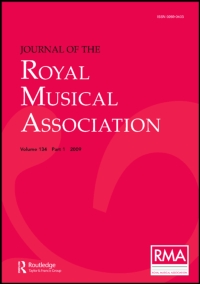Article contents
Calvin's First Psalter, 1539
Published online by Cambridge University Press: 01 January 2020
Extract
After the very erudite paper on the Genevan Psalter which was read before this Association (in June, 1918) by Dr. Woodward, there is very little ground left for me to cover.
The whole question of metrical psalmody has been so thoroughly ventilated by so many authorities that but for the little book we are to discuss this afternoon, I doubt if I should have had anything fresh to say to you.
- Type
- Research Article
- Information
- Copyright
- Copyright © Royal Musical Association, 1930
References
1 “The Psalms in Human Life,” page 178 et seq.Google Scholar
2 Pace Lord Ernie, it is doubtful whether they continued in use amongst Catholics for any great length of time after the death of Francis I. By 1543 at least six Huguenot editions of vernacular psalms had been placed on the Index expurgatorius of the faculty of Theology in the University of Paris.Google Scholar
3 How universal was the practice of singing metrical psalms in the home may be gathered from the fact that as late as 1599 the Englishman Alison, in his psalter, provided accompaniments for lute and cittern—a presumable indication of the custom of singing psalm tones as solos.Google Scholar
4 “Histoire du Psautier des Eglises réformées.”Google Scholar
5 This is problematical, as Calvin returned to Geneva in 1541Google Scholar
6 “Clement Marot et le Psautier Huguenot; etude historique. littéraire, musicale et bibliographique.”Google Scholar
7 Douen's superficial exanination of it is exemplified in Vo. 1, page 302 of his “Clement Marot et le Psautier Huguenot,” where he says that Calvin's work (he describes it as “absolutely anonymous”) consists of “18 psalms. 3 cantiques; 21 pieces in all, each of which has its melody in the first verse.” There are really 22 pieces; 19 of them psalms. He has overlooked Psalm cxv which has no tone.Google Scholar
8 Not eleven, as is assumed by all writers on the subject, whom I have consulted.Google Scholar
9 I was at first inclined to think that the note Mi at the end of line 7 (which we sing as Sol, and which stands Sol in the later editions of the Genevan Psalter) was another instance of a common sixteenth-century misprint (a third too low). But on looking up Zahn (Vol. V, page 101, No. 8303) I found authority for Calvin's reading.Google Scholar
10 See his series of articles on the Genevan Psalter (quite remarkable for their period) which appeared in “The Musical Times” of 1881.Google Scholar
11 My italics (R.R.T.).Google Scholar
12 Marie of Austria, sister of Charles V and then Regent of the Netherlands.Google Scholar
13 My italics (R.R.T.).Google Scholar
14 Calvin sets Psalm 137 (“By the waters of Babylon”) to it. The original carol has fourteen verses and begins: “Esprits divins, chantez de la nuict saincte.”Google Scholar
- 1
- Cited by


